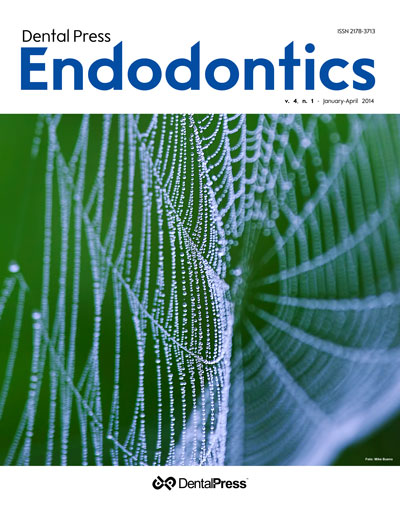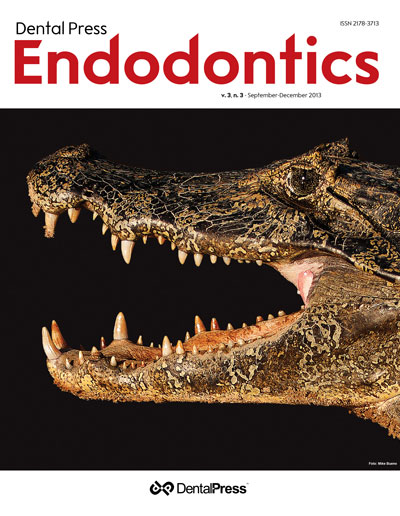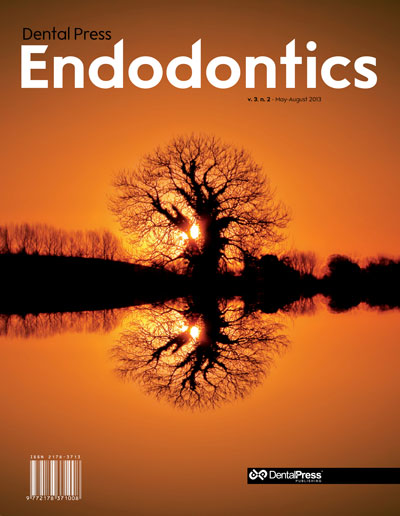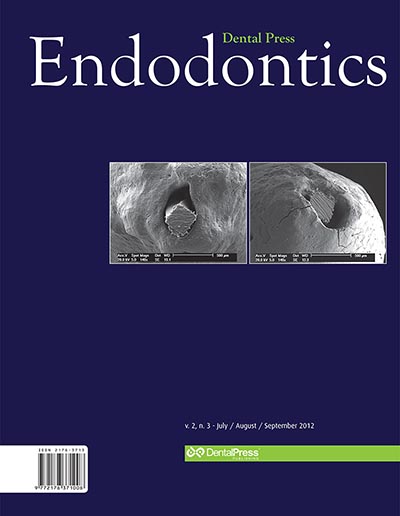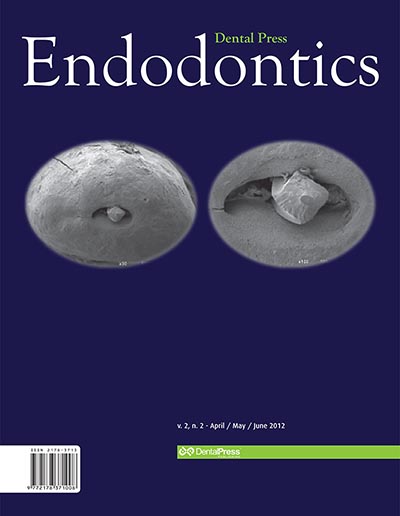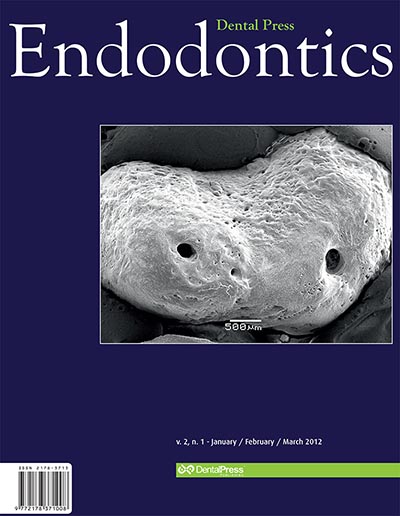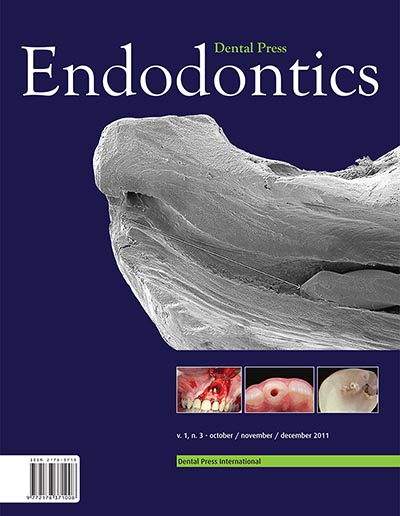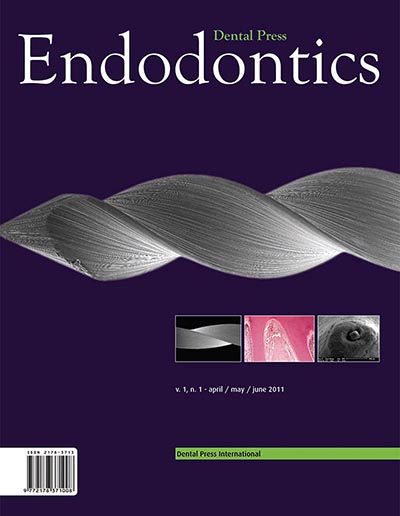Current issue
Dental Press Endodontics – ISSN 2178-3713
Dental Press Endod.
v. 03, no. 1
January / February / March
2013
Editorial
Perspectives for the therapeutic success
03 03
The scientific revolution that Endodontics is experiencing is spectacular. Many discoveries boosted the progress, promoting new and important resources which contribute to greater success in the endodontic treatment.
Strategies for navigating in cone beam computed tomography (CBCT) images brought new perspectives to the outcomes and monitoring of endodontic treatment. However, the estimates of success when using CBCT should be reassessed and treatment protocols should be reviewed and, if necessary, redirected. This is because, although the results are still preliminary, endodontic treatments were observed with higher failure rates when analyzed by CBCT than by means of periapical radiographs. However, regarding its radiation dose, cost-effective and proper recommendation, this imaging exam, routinely performed, still needs further and careful discussion.
There is a large number of specialization courses in Brazil, which demands greater care with teaching. For this reason, the adoption and critical monitoring of stricter therapeutic protocols, aiming at improving the quality of endodontic treatment should always be prioritized.
Every scientific progress brings a new challenge. Often, this advance can change a decision, but it must be grounded in effectiveness. This is one of the reasons for permanent updating with scientific knowledge, aiming at the use of a therapeutic protocol that brings greater expectation of successful treatment.
Carlos Estrela
Editor-in-chief
Endo in Endo
Pulp repair: The reconstruction is done with granulation tissue — the pulp repairs itself, and does not regenerate itself!
Dental pulp. Pulp repair. Incomplete root formation. Dentin.
9 42
Original Article
Evaluation of EDTA, apple vinegar and SmearClear with and without ultrasonic activation on smear layer removal in different root canal levels
Smear layer. Chelating agents. Ultrasonics.
43 48
Objective: This in vitro study evaluated the efficiency of EDTA, apple vinegar and SmearClear, with and without ultrasonic activation, on smear layer removal.
Methods: Seventy extracted canines were randomly divided into eight groups and prepared by using ProTaper instruments. The final irrigation regimens used were: Group 1 (control) (SAL) and Group 2 (control) (SALUS): saline for 3 minutes without and with ultrasonics, respectively; Group 3 (EDTA) and Group 4 (EDTAUS): 17% EDTA for 3 minutes without and with ultrasonics, respectively; Group 5 (AV) and Group 6 (AVUS): apple vinegar for 3 minutes without and with ultrasonics, respectively; Group 7 (SC) and Group 8 (SCUS): SmearClear for 1 minute without and with ultrasonics, respectively. Specimens were then examined under scanning electron microscope and scored for smear layer removal on the coronal, middle and apical thirds.
Results and Conclusions: Smear layer removal was most efficient when 17% EDTA and SmearClear were used, compared to apple vinegar. Ultrasonics did not improve the smear layer removal significantly in all groups. The poorest results were observed in the apical third of the root canal, with statistical differences between the coronal third in all irrigation regimens.
Comparison of the torsional fatigue resistance of PathFile nickel-titanium files with other small 0.02 mm taper files
Endodontics. Fatigue. Rotary drilling.
49 53
Objective: The purpose of this study was to compare the torsional fracture resistance of the following 0.02 mm taper files: PathFile size #13, #16, and #19, ProFile size #15 and #20, K3 size #15 and #20, Quantec LX size #15 and #20, and Liberator size #15 and #20.
Methods: Eleven groups of files with 20 samples in each group were tested. The files were secured in the chucks of a torsiometer and rotated until fracture occurred. The maximum torque and degrees of rotation before fracture were recorded. Files of similar tip size were compared with one another for significant differences. One way ANOVA and Tukey’s post hoc test were used to identify statistically significant (p < 0.05) differences between the groups.
Results: The Liberator size #15 and #20 separated at significantly lower torque than all other similar sized files, while the PathFile size #16 separated at significantly higher torque than the size #15 files to which it was compared.
Conclusion: The torsional fatigue resistance of PathFiles were better when compared to other small tip size #0.02 taper files.
Human enamel colonization of Candida albicans
Infection. Periapical diseases. Dentin.
54 60
Introduction: Candida albicans may be a commensal member of the oral microbiota, and may colonize the endodontic environment. Using an in vitro dentin infection model, the objective of this study was to evaluate the pattern of dentin colonization by C. albicans and the influence of thigmotropism on the colonization.
Methods: An apparatus was designed being composed of two glass flasks connected by a silicone manifold. Internally, they were separated by a dental fragment protruding an acrylic disk. The upper and bottom flasks were filled with Sabouraud broth and C. albicans was inoculated in the upper flask. After 72 h at 37 ºC, the device was aseptically dismounted and the dentinal fragment was prepared for scanning microscopy.
Results: Candida albicans 1015 strain actively penetrated dentinal tubules and hyphae were the mainly growth form for the primary yeast invasion of human dentin. Yeast cells were observed in inner dentin layers.
Conclusions: The direction of the hyphal tip was not influenced by the tubular nature of the dentin. In his view, only the pleomorphism has a significant role in the fungal colonization of human dentin.
Case Report
The influence of calcium hydroxide paste change on repairing of extensive periapical lesions: Cases report
Calcium hydroxide. Periapical abscess. Propylene glycol.
61 67
Introduction: In this paper we describe the endodontic treatment of teeth with extensive periapical lesions through case reports.
Objective: Analyze the effectiveness of change the intracanal medication with calcium hydroxide, reducing or eliminating the surgical procedures and still observe, by follow up, the periapical repair.
Results: After clinical and radiographic examination and found the need for endodontic treatment, was performed the coronal opening, irrigation with sodium hypochlorite 1% and biomechanical preparation with manual endodontic files. The EDTA 17% was used for 3 minutes with manual shaking before application of the medication in all the sessions as well as all sessions before the final filling. Thus, the medication with calcium hydroxide and propylene glycol was inserted in the root canal and replaced whenever the medication had been partly resorbed. After the beginning of periapical repair, the filling of the root canals was performed by the technique of horizontal and vertical condensation and radiographic controls were performed according to the availability of the patients.
Conclusion: In these case reports, the renovation of calcium hydroxide as root canal dressing showed efficient in the treatment of extensive chronic periapical lesions, repairing the bone and periodontal tissues and eliminated the need for surgical intervention.
Emergency endodontic care of patient with inconclusive diagnosis of von Willebrand disease
Von Willebrand factor. Endodontics. Periapical abscess.
68 72
Introduction: Patients presenting bleeding disorders need special care when submitted to dentistry procedures.
Objectives: The aim of this case report is to provide information on how to handle a patient with a probably diagnosis of von Willebrand disease and acute periapical abscess in tooth #23.
Methods: The patient was a white female, 35 years old, who presented to the emergency program of the School of Dentistry - Federal University of Paraná, Brazil, with extensive decay below gum level, projecting into the palate, and crown fracture exposing the root canal to the oral environment. Attention was focused on isolating the operative field, which could not be done in the conventional manner due to the extension of the caries, the proliferation of gum tissue and the patient’s systemic conditions.
Conclusion: The strategy used in this case was effective in management of coagulopathy and allowed for emergency care to be carried out without complications.
Maxillary first premolar with three roots: Case report
Anatomy. Bicuspid. Dental pulp cavity.
73 77
Introduction: The maxillary first premolar may rarely present with three roots, two buccal and one palatal, demanding more attention during endodontic intervention.
Objective: This paper reports the case of a maxillary first premolar with three roots and three root canals, highlighting the difficulties and special care during endodontic treatment.
Methods: After initial radiography and coronal opening, the presence of three roots and three root canals was detected. The exploration of the canals was performed with #10 K-file and the root canal length was measured by means of radiographic technique, which made it possible to confirm the anatomical variation and to assure that the buccal canals were independent. The instrumentation was mixed, with K-type hand files, until #35 file, automatized with ProTaper® system (Dentsply). The filling of the canals was performed with the lateral compaction technique with sealer Sealer 26®.
Conclusion: Professionals should always carefully consider the diagnostic radiograph and perform all steps of root canal treatment properly, so that possible changes can be detected, not compromising the success of treatment.
Late treatment of dental trauma using apexification technique
Incomplete root formation. Calcium hydroxide. Apexification. Immature teeth.
78 83
Introduction: A 37 years old male patient was admitted to the clinic of endodontics. After anamnesis it was found that the tooth #11 had coronary open access and the presence of calcium hydroxide with dental trauma history. Radiographically, the tooth had incomplete root formation, thin and fragile dentin walls and foraminal divergence associated with periapical radiolucent image.
Objective: To report a clinical case of apexification, performed with calcium hydroxide dressing.
Methods: The treatment chosen was the apexification that began in the second session, after 15 days, through chemomechanical debridement of the entire root canal, with K files and irrigation with 2,5% sodium hypochlorite solution. Then, the calcium hydroxide paste (calcium hydroxide, iodoform and propylene glycol) was applied and changed every 15 days over four months. The radiographic exam demonstrated the complete closure of the foraminal opening and regression of periapical radiolucency. The root canal was filled using a cone made from the union of three master cones #60 and lateral condensation technique with Sealapex®.
Results: Six months after the filling, tests revealed normal periapical tissues and absence of symptoms.
Conclusion: It was concluded that the treatment of dental trauma associated with dental pulp necrosis and periapical lesions with successive changes of calcium hydroxide paste was adequate to obtain the regression of periapical lesion, formation of a mineralized barrier and promotion of patient’s health.
Original Article
Evaluation of response to pulp sensitivity test with cold in teeth with non-carious cervical lesion
Tooth abrasion. Tooth erosion. Dental pulp. Dental pulp test.
84 87
Objective: To evaluate the response to cold pulpal sensitivity test in teeth with loss of dentinal structure by non-carious cervical lesion.
Methods: Eighteen patients from School of Dentistry of University of Passo Fundo were selected for the present study. In these patients, were analyzed forty single-rooted teeth which filled the inclusion criteria, being divided into two groups: G1 = 20 teeth showing non-carious cervical lesions; and G2 (control) = 20 teeth without loss of dentinal structure. The patients were instructed regarding to pain level, through a visual analog scale which classified the painful response in mild, moderate and severe. From the obtained information, the data were statistically analyzed using nonparametric Kolmogorov-Smirnov test at 5% significance level.
Results: The results of the present study have not showed statistically significant difference between Group 1 and Group 2, regarding to response to pulp sensitivity test with cold (p < 0.05).
Conclusion: It was concluded that teeth with non-carious cervical lesion can demonstrate different levels of response to cold pulp sensitivity test, suggesting that teeth with loss of dentinal structure can or cannot show a response related to pulp sensitivity.
Case Report
Horizontal root fracture in the middle third: Case report
Endodontics. Dental trauma. Root fracture.
88 93
Introduction: Dental trauma may be considered one of the main causes of permanent teeth loss, and root fractures are relatively uncommon in these situations.
Objective: The aim of this study was to report a clinical case of horizontal root fracture promoted by a dental trauma and discuss their clinical implications.
Methods: The horizontal root fracture occurred at the middle third of the maxillary central incisor with separation of the fragments. The tooth was diagnosed with pulp necrosis, and the endodontic treatment was performed.
Results: After a follow-up period of two years with radiographic and tomographic images root complications were not observed, neither painful symptomatology, highlighting the importance of a correct diagnosis which results in a good prognosis, preserving the esthetic and psychological integrity of the patient.


